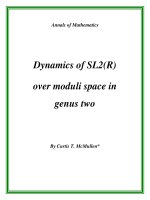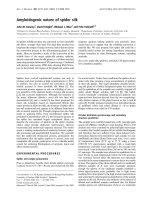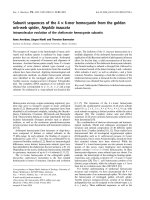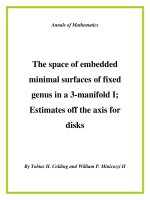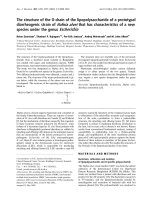genus spider ocrisiona
Bạn đang xem bản rút gọn của tài liệu. Xem và tải ngay bản đầy đủ của tài liệu tại đây (1.67 MB, 19 trang )
AUSTRALIAN MUSEUM
SCIENTIFIC PUBLICATIONS
Zabka, Marek, 1990. Salticidae (Araneae) of Oriental, Australian and Pacific
Regions, IV. Genus Ocrisiona Simon, 1901. Records of the Australian Museum
42(1): 27–43. [23 March 1990].
doi:10.3853/j.0067-1975.42.1990.105
ISSN 0067-1975
Published by the Australian Museum, Sydney
nature
nature culture
culture discover
discover
Australian
AustralianMuseum
Museumscience
scienceisisfreely
freelyaccessible
accessibleonline
onlineatat
wwwww.
a
u
s
t
r
a
l
i
a
n
m
u
s
e
u
m
.
n
e
t
.
a
u
/
p
u
b
l
i
c
a
w. a u s t r a l i a n m u s e u m . n e t . a u / p u b l i c atti o
i onnss/ /
66 College
College Street,
Street, Sydney
Sydney NSW
NSW 2010,
2010, Australia
Australia
Records of the Australian Museum (1990) Vol. 42: 27-43 .
ISSN 0067 1975
27
Salticidae (Araneae) of Oriental,
Australian and Pacific Regions, IV.
Genus Ocrisiona Simon, 1901
MA..REK ZABKA *
Visiting Fellow, Australian Museum
P.O. Box A285, Sydney South, NSW 2000, Australia
*Present Address: Zaklad Zoologii, WSR-P
08-110 Siedlce, P91and
ABSTRACT. The spider genus Ocrisiona Simon is revised. Eight species are diagnosed, described and
illustrated, five new ones are established: O. eucalypti, O. koahi, O. parmeliae, O. victoriae and
O. yakatunyae. Four species, O. aerata (L. Koch), O. elegans (L. Koch), O. Jrenata Simon and
O. parallelistriata (L. Koch), are excluded as not related, three additional ones, O. complanata (L. Koch),
O.fusca (Karasch) and O. invenusta (L. Koch), are transferred to Holoplatys. The genus is redefined and
its relationships are discussed. Remarks on biology are presented, maps of distribution and key to the
species are given. Geographical distribution of Ocrisiona is limited to Australia and adjacent areas;
O. leucocomis (L. Koch) and O. melanopyga Simon are mainland species also recorded from Tasmania,
and O. melancholica (L. Koch) is also known from Lord Howe Island.
ZABKA, M., 1990. Salticidae (Araneae) of Oriental, Australian and Pacific Regions, IV. Genus Ocrisiona
Simon, 1901. Records of the Australian Museum 42(1): 27-43.
Since its original description the taxonomy of Ocrisiona
has not been studied. One species was illustrated by
Proszynski (1984) but without any further comments. The
synonymisation of the genus with Holoplatys (Proszynski,
1987) was premature. Simon (190 la) provided the first clear
diagnosis of the genus based upon morphological criteria,
but even his taxonomic decisions were partly wrong. From
among 12 species of Ocrisiona listed by Bonnet (1958)
three of Koch's species - O. aerata, O. elegans and
o.parallelistriata -and O.frenata Simon (190 1b) should be
excluded as they represent other taxa. The type specimens
of O. cinerea and O. liturata cannot be found but their
original descriptions suggest that both should be
transferred to H oloplatys, as well as O. complanata, O.fusca
and O. invenusta.
Material and Methods
The work is based on type specimens listed by
Proszynski (1971) and on new material deposited in the
28
Records of the Australian Museum (1989) Vol. 42
museums listed below. For O. melancholica and
O. melanopyga type specimens have not been found. For
each species five specimens of each sex from different
localities were measured (in mm), if available.
Measurements are given as a range and mean (in brackets).
The details on terminology and measurements are
illustrated in Fig.I. Spination of tibia and metatarsus I and 11
are given as useful taxonomic characters both at specific
and generic level; the format of their description follows
Platnick & Shadab (1975). The specific names of new
species (except O. eucalypti) are derived from the type
localities.
Collections studied are: AMS - Australian Museum,
Sydney; QMB -Queensland Museum, Brisbane; TMHTasmanian Museum and Art Gallery, Hobart; W AMP Western Australian Museum, Perth; MNHN - Museum
National d'Histoire Naturelle, Paris; ZMH - Zoologisches
Institut und Zoologisches Museum Universitiit, Hamburg.
Abbreviations used are: AEW - anterior eyes width; ag
- accessory gland; AL - abdomen length; ALE- anterior
lateral eyes ; CL - cephalothorax length; CW cephalothorax width; dh - distal haematodocha; e embolus, EFL-eye field length; fd - fertilisation duct; idinsemination duct; PEW - posterior eyes width; PLE posterior lateral eyes; s - spermatheca; sr - seminal
reservoir; t - tegulum; ta - tibial apophysis.
Key to the Species of Ocrisiona
Males
1.
Abdomen with large pale patches posteriorly. Tibia I
with single distal prolateral spine .............................................................. .......... O. melancholica
Abdominal pattern and leg spination not as above .................................................................... 2
2.
Abdomen with 2 or 3 pairs of yellow spots alongside
a pale median stripe. Anterior abdominal scutum
indistinct but present ............................................................................................. O. leucocomis
Abdominal pattern not as above, scutum absent ........................................................................ 3
3.
Embolus longer than tegulum, distal haematodocha
reduced ........................................................................... ............................. 0. yakatunyae n.sp.
Embolus shorter than tegulum, distal haematodocha
large ........................................................................................................................................... 4
4.
Pal pal tibia short and wide, tibial apophysis large,
bent laterally. Cephalothorax with longitudinal
median stripe of white hairs, no spines on tibia 11 ........................................... O. parmeliae n.sp.
Palpal tibia longer than wide, tibial apophysis smaller,
medial stripe only on thoracic part of cephalothorax,
tibia 11 with one distal prolateral spine .................................................. ............ 0. victoriae n.sp.
Females
1.
Robust spiders, 3 pairs of spines on tibia I,
insemination ducts of epigyne broad, in the shape of
reversed "U" ......................................................................................... ............ . O. melanopyga
Body form more slender, at most 2 pairs of spines on
tibial ................................................ ................ ... ......................................................... ............... 2
2
Abdomen with large vast light patches posteriorly.
Tibia 11 with single distal prolateral spine .......................................................... O. melancholica
Abdominal pattern and leg spination different .......................................................................... . 3
Zabka: Genus Ocrisiona
3.
29
Abdomen with 2 or 3 pairs of yellow spots alongside
.
a pale mid-dorsal stripe .......................................................................................... O. leucocomls
Abdomen not as above .............................................................................................................. 4
4.
Cephalothorax with longitudinal median stripe,
.
abdominal pattern as in Fig. lOA ...................................................... ...................... 0. koahl n.sp.
.
No median stripe on cephalothorax. Small clusters of
white hairs around fovea and behind PLE ..................................................... 0. eucalypti n.sp.
Taxonomic Survey
Ocrisiona Simon, 1901
Marptusa [part] L. Koch, 1879 : 1100.
Ocrisiona Simon, 1901a: 595, 602, 604, 608.
Diagnosis. Flat, 'unident', generally dark spiders.
Thoracic part of cephalothorax elongated, rather wide.
Compared to Holoplatys no cephalic depressions between
PLE. Legs usually heavily haired, especially in males. Legs
I the strongest, legs IV the longest, legs III the shortest or
as long as legs II. Tibial spines on legs I and II always
present. Male pal pal organs with long, thin embolus. Lateral
tibial apophysis often with small protuberance, no dorsal
apophysis. The epigynal pattern is an inverted heart shape.
Description (Fig. I). Medium to large spiders, body
length 6-15 mm. Cephalothorax robust, flat and wide, much
wider than the distance between posterior lateral eyes,
black, often with median or marginal belts of white hairs.
Compared to Holoplatys no cephalic depressions between
PLE. Abdomen black or brown with pattern of white hairs
or light patches characteristic for each species. Spinnerets
brown to black. Clypeus narrow, sometimes heavily haired
but without distinctive fringe. Chelicerae restrainedly
strong, with 2 promarginal teeth and 1 retromarginal
tooth. Maxillae, labium and sternum elongated. Legs strong
and long, usually heavily haired, especially in males. Legs I
the strongest, legs III the shortest or as long as legs II.
Tibial spines on legs I and 11 present. The number and size
of the tibial spines tend to be reduced. In O. melanopyga, 3
pairs of spines on tibia I, whereas in other species 2 or
fewer pairs are present. Palpal organs simple, similar in
structure to some Holoplatys species (Zabka, in
preparation) but dorsal apophysis on tibia never present.
Lateral apophysis shows specific variability. Tegulum
rather oval, embolus long, based on soft, membraneous
distal haematodocha. Epigyne in the form of inverted
hearth divided by central bridge. Internal structures
translucent, insemination ducts of the shape of reversed
"U" or "V". Spermathecae pear-shaped, accessory glands
long. Female body usually longer, especially abdomen.
Male first legs longer and more haried than those in
females.
Relationships. General similarities to some species of
Holoplatys (Zabka, in preparation): body shape, genitalia
and legs structure shows both genera to be closely allied.
The morphology of particular species, especially their
cephalothorax proportions and leg spination suggest that
the genus probably derived from large, robust spiders
showing a tendency to live under bark - at least as
facultative inhabitants. A process of specialisation effected
a gradual body flattening and reduction of spines on tibiae
I and n. Apart from representatives of the related genus
Holoplatys there are some other species known as "Breda
jovialis (L.K.)" and "Menemerus bracteatus (L.K.)" (both
described under wrong generic names) which present
some similarities in body shape and epigyne structure; their
palpal organs, however, are quite different. As far as I can
determine none of the described Australian, South
American and African genera of jumping spiders can be
regarded as ancestors of Ocrisiona. Thus Ocrisiona
probably originated on the Australian continent and
represents one of its many endemic genera.
Similarities of genitalia between many, even unrelated,
groups of Salticidae are a good example of convergence.
Probably very sophisticated behavioural and also
ecological and geographical mechanisms were adequate to
provide effective isolation and, in such cases, natural
selection did not prefer any large variability of genitalic
structure. Such a situation makes identification rather
difficult, especially for those who treat genitalia as the only
taxonomic character. Therefore other taxonomic
characters such as armament of first and second legs, body
size and ratios, and colouration are highly recommended.
Biology. Ocrisiona species can be found mostly under
bark of Eucalyptus. Single specimens of O. melancholica
have also been found under Araucaria bark (North
Queensland) and under lichen on rock surfaces (Lord
Howe Island). There is one report from Queensland about
O. leucocomis being implicated in human envenomation.
Local swelling and erythema occurred without any further
consequences. Being moderately large spiders some
species are probably able to penetrate human skin. The
symptoms mentioned could be an individual allergic
reaction. In fact, no detailed data about the venom of
jumping spiders is available.
Distribution. Ocrisiona seems to be an endemic
30
Records of the Australian Museum (1989) Vol. 42
be expected in New Guinea.
Australian genus. Only single species have expanded their
ranges to adjacent areas, possibly introduced by man or
dispersed in other ways. Ocrisiona leucocomis and O.
melancholica are mainland species which also occur in
Tasmania and Lord Howe Island respectively. Ocrisiona
melanopyga is reported from Tasmania only. The localities
of some species in North Queensland and, especially, in
Torres Strait, suggest that representatives of the genus can
Ocrisiona leucocomis (L. Koch, 1879)
Figs 2A-C, 3A-E, Map 1
Marptusa leucocomis L. Koch, 1879: 1096.
Ocrisiona leucocomis.--Simon, 1901a: 596, 602, 608,
609.
.
.
••••
.' I"
.•...
<0, ••
..
~--cw-_--'--J
'----"---"---id
. ---ag
,~
E
~ef
------=--
F
tJ-ta
Fig.I. General characters of Ocrisiona. A: dorsal view: CL - cephalothorai length; AL - abdomen
length; EFL - eye field length; TB - thorax. B: cephalothorax: AEW - width of ALE; PEW - width of
PLE; CW - cephalothorax width. C: lateral view of cephalothorax. D: sternum. E: internal structures of
epigyne: id -'- inserirination duct; fd -'- fertilisation duct; s -'-- spermatheca; ag - accessory gland. F: palpal
organs: e - embolus; dh - distal haematodocha; sr - seminal reservoir; i - tegulum; ta - tibial
apophysis.
Zabka: Genus Ocrisiona
Fig.2. Male Ocrisiona leucocomis. A -'- general appearance; B-C locality).
palpal organ (syntype from type
31
32
Records of the Australian Museum (1989) Vol. 42
Fig.3. Female Ocrisiona leucocomis. A (A, D-E - syntype from type locality).
general appearance; B-E -
epigyne and its internal structures
Zabka: Genus Ocrisiona
Material
examined.
QUEENSLAND:
female,
Kuranda, Black Mountain, 396 m, edge of wet sclerophyll
and rainforest, 19 June 1974, N.C. Coleman, det. M. Gray,
AMS KS18868; 1 female, Kuranda area, 1951, J.G.
Brooks, AMS KS 177 41; 2 males, 3 females, 1 juvenile,
syntypes, Peak Downs, Sydney, Bowen (Mus. Godeffroy
16523), ZMH; 1 female, B1ackdown Tableland,
south-west of Rockhampton, 5-6 Oct. 1982, A. Rozefe1ds,
QMB S4608; 1 female, Blackdown Tableland via Dingo,
1-6 Feb. 1981, R. Raven, QMB S458; 1 female, Mount
Garnet, 24 Feb. 1972, N.C. Coleman, QMB S4577; 1
male, Kroombit Tops (Upper Dry Creek), 45 km
south-west of Calliope, open forest, 9-19 Dec. 1983, V.
Davies, J. Gallon, QMB S4569; 2 males, 1 female,
2 juveniles, Muncoonie via Birdsville, campsite, 14 Nov.
1976, QMB S4615; 2 females, 1 juvenile, desert sand
plain, R. Raven, QMB S4604; 1 female, Miles, 14 Dec.
1984, J. Gillet, QMB S4562; 2 females, Oakey, Feb. 1979,
T. Adams, QMB S4561; 1 male, 1 female, Brisbane, Lake
Broadwater, buildings, 1-15 Nov. 1984, V. Wood, QMB
S4614, 1 female under bark, 24 Aug. 1984, M. Bennie,
QMB S3635; 1 female, Brisbane, Rochedale S.F., beating,
7 Dec. 1979, V. Davies, R. Raven, QMB S4586; 1 female,
10 km south-east of Stanthorpe, 8 May, 1983, A. Rozefelds,
QMB S4576. NEW SOUTH WALES: 1 male, Armidale,
1 Jan. 1982, R. Mascord, AMS KS 10425; 1 female,
Yarramundi, 19 Sept. 1966, R. Mascord, AMS KS18867;
1 female, Tarana, 23 Apr. 1966, R. Mascord, AMS
KS 18870; 1 male, 1 female, Blue Mountains, Shaw' s
Creek, 7 Aug. 1968, R. Mascord, AMS KS 18869;
1 female, Lindfield, May 1976, A. Doubleday, det.
M. Gray, AMS KS18873; 1 male, Botany, 7 Jan. 1975,
R. Mascord, AMS KS 18874; 1 female, Pambula,
"Fernbank", H. Forde, AMS KS18865. WESTERN
AUSTRALIA: 1 male, Perth, Museum building, 16 Jan.
1980, K. McN amara, W AMP 88/32; 1 female, Horseshoe
Cave near Madura, floor, 13 Feb.-l Mar. 1970, M. Archer
group, WAMP 74/117; 1 female, Madura, Roaches Rest
Cave, surface, 27 Dec. 1967, M. Gray, AMS KS18866.
TASMANIA: 1 female, Snowy Mountains Range, 457 m,
Feb. 1939, C.D. King, TMH J2754. No LOCALITIES: 2
females, Jan. 1908, Harris, AMS KS 17861; 1 female, AMS
120
135
150
165
33
KS18252.
Diagnosis. The species can be recognised by the
following combination of characters: abdomen with 2 or 3
pairs of light spots along pale mid-dorsal stripe, central
stripe of white setae along cephaloth6rax, length of male
embolus and shape of tibial apophysis, curved accessory
glands of female epigyne.
Male (Fig.2A): cephalothorax almost black with median
thoracic stripe of white hairs, less numerous marginal white
hairs also present. Abdomen dark grey to black, its anterior
part with a poorly visible scutum. Medium lOI1gitudinallight
stripe with more or less distinct 2 or 3 pairs of lighter spots.
Clypeus dark-brown to black with whitish hairs, chelicerae
of the same colour with similar hairs basally. Maxillae and
labium dark brown to black with lighter tips, sternum brown
to black, venter and spinnerets grey brown to black. Legs I
of the same colour as body, haired, legs II-IV slightly
lighter. Palpal organ (Fig.2B~C) with relatively long
embolus, distal haematodocha distinct, tibial apopllysis with
characteristic protuberances.
Leg spination: tI: p 1-1, rO-O; mI: p 1-1 ,ri-I; tII: pO--l, rO-O;
mII:pl-'l,rl-1.
Dimensions: CL-2.57-4.29 (3.28); CW:--. 1.84-3,16(2.32);
ratioCW:CL-0.67--D.73 (0.70);EFL-O,85-132(1.05);ratio
EFL:CL-0.31--D.33 (0.32); AEW -1.36-1.98 (l :59); PEW1.37-2.11 (1.66);AL-2.57-5.41 (3.71).
Female (Fig. 3A): the body coloured as in male, but
specimens usually larger, more robust, legs I relatively
shorter. Epigyne (Fig.3B..,.E) typical in the form,
insemination ducts long, accessory glands curved.
Leg spination:tI: pl-l ,rO-O; rtlI: p 1..,.1 ,r1~ 1; tII: pO--l ;rO-O;
mII:pl-l,rl-1.
Dimensions:CL-4.09-5.41(4.60);CW-2.87-3.89(3.23);
rationCW:CL-0.68--D.72(O.69);EFL:--.l.:25-1.58(1.38);ratio
EFL:CL-0.29--D.31 (0.30); AEW -1,91 '-2.31 (2.09); PEW ~
1.98-2.51 (2. 19);AL-5.28-9.43 (6.54).
In the original descripti()n no holotype specimen was
designated. The localities "Sydney; Bowen and Peak
Downs" were given but the origin of each individual in the
syntype series (see above) is unknown.
Distribution (Map 1). Widespread species from North
Queensland through New South Wales and Tasmania to
Western Australia.
Ocrisiona melanopyga Simon, 1901
Fig. 4A-C, Map 2
Ocrisiona melanopyga Simon, 1901b: 160.
Material
examined.
Launceston, MNHN 4.736.
Map l. Distribution of O. leucocomis (L.K.).
TASMANIA:
female,
Diagnosis. Robust spider, cephalothorax and
abdomen much wider than in other species, legs I with 3
pairs of tibial spines, dorsal stripe of white hairs on
pedipalps, insemination ducts of epigyne broad, especially
34
Records of the Australian Museum (1989) Vo!. 42
proximally.
Female (Fig. 4A): cephalothorax robust. Eye field black,
thorax brown with white hairs along its median and marginal
part. Abdomen dark brown, centrally slightly paler with
transverse stripes posteriorly. Whitish hairs present,
especially anteriorly and laterally. Spinnerets blackish.
Clypeus and chelicerae black brown, the last with single
white hairs. Pedipalps orange brown with dorsal
longitudinal stripe of white hairs and long lateral fringes.
Maxillae and labium black brown with yellow tips, sternum
red orange, venter beige. Legs I strong, black brown,
others slightly paler. Epigyne (Fig. 4B-C) in the form of
triangular depression, insemination ducts broad proximally,
distally gradually narrower.
Leg spination: tI: pI-I-I, rI-I-I; mI: pI-I, rI-I; tIl: pI-I,
Fig.4. Female Ocrisiona melanopyga. A structures (specimen from Launceston).
rI-I; mIl: pl-l,rI-l.
Dimensions: CL-5.30; CW -4.09; ratioCW:CL-0.81;
EFL-I.58; ratio EFL:CL-0.30; AEW - 2.44; PEW - 2.57; AL
-5.94.
The original description (Simon, 1901) is based on a male
specimen only. A female from the Paris collection has
never been described but it has been identified by Simon
himself and also its locality suggests it represents
O. melanopyga. The robust body and spination of tibia I
suggest that this species can be the closest to the ancestors
of the genus.
Distribution (Map 2). The species is known only from
Launceston in Tasmania.
general appearnace; B-C -
epigyne and its internal
Zabka: Genus Ocrisiona
Ocrisiona victoriae n.sp.
Fig. 5A-C, Map 2
Material examined. VICTORIA: Holotype, 1 male,
Melbourne, Mar. 1981, D. Hill, QMB S4584.
Diagnosis. Abdomen with wide light dorsal stripe,
palpal embolus shorter than in other species, accompanied
by large distal haematodicha, tibial apophysis with
characteristic cusps.
Male (Fig. 5A): robust spider. Cephalothorax dark
brown with white hairs medially and single ones marginally.
2.05
Fig.5. Male Ocrisiona victoriae n.sp. A -
35
general appearance; B-C -
palpal organ.
36
Records of the Australian Museum (1989) Vo!. 42
Abdomen black with light dorsal stripe. Spinnerets black
brown. Clypeus and chelicerae black, maxillae dark brown
with whitish tips, labium dark brown. Sternum brown,
venter beige with 2 longitudinal darker streaks. Legs I dark
brown, the others slightly larger. All, but especially first
legs, covered with dark and whitish hairs. Palpal organ
(Fig. 5B-C) more elongated than in other species, embolus
shorter, distal haematodicha larger, tibial apophysis with
internal cusps.
Leg spination: tI: pl-l,rO-O; mI: pl-l ,rl-l; tII: pO-I ,rO-O;
mII:pl-l,rl-l.
Dimensions: CL-4.95; CW - 3.49; ratioCW:CL-O.70;
EFL-I.52;ratioEFL:CL-O.30; AEW - 2.24; PEW -2.37;
AL-4.75.
Distribution (Map 2). This species is known only from
the single Melbourne locality.
Ocrisiona parmeliae n.sp.
Fig. 6A-C, Map 2
Material
examined.
WESTERN
AUSTRALIA:
male, Parmelia, 2 Nov. 1986, A.E. de Jong,
WAMP 88/46.
HOLOTYPE
~I
~I
Fig.6. Male Ocrisiona parmeliae n.sp. A -
general appearance; B-C -
palpal organ.
Zabka: Genus Ocrisiona
Diagnosis. The species can be recognised by the
following combination of characters: wide mid-dorsal stripe
of white hairs along the body. Tibia of palpal organ shorter
and wider than in other species, with dorsolateral
protrusion, notched on internal edge. Body size relatively
small (6 mm).
M ale (Fig. 6A): black spider with characteristic pattern of
white hairs. Clypeus with long black hairs. Chelicerae with
single whitish scale-like setae, maxillae with lighter tips.
Legs I with black hairs, especially on ventral patella and
tibia. Other legs less haired. All legs also with white hairs.
Palpal organ (Fig. 6B-C) similar to in 0 .leucocomis but tibia
shorter and wider and its apophysis of different shape.
Leg spination:tI: pl-l ,rO-O; mI: pl-I,rl-I; t1I: pO-O,rO-O;
mII:p1-1,rO-l.
Dimensions: CL-2.90; CW - 2.04; ratioCW:CL-0.70;
EFL-1.05;ratioEFL:CL-0.36;AEW -1.48;PEW -1.55;
AL-3.04.
Distribution (Map 2). This species is known only from
the single Parmelia locality.
Ocrisiona melancholica (L. Koch, 1879)
Figs 7A-E, 8A-C, Map 3
Marptusa melancholica L. Koch, 1879: 1113.
Ocrisiona melancholica.-Rainbow, 1911: 292.
Material examined. QUEENSLAND: 1 female, Leo
Creek, under bark of Araucaria cunninghami, 15 Aug.
1972, B. Gray, AMS KS13074; 1 female, Kroombit Tops
(Upper Kroombit Creek), 45 km south-west of Calliope,
open forest, 9-19 Dec. 1983, V. Davies, J. Gallon, QMB
S4589; 1 juvenile, rainforest, QMB S4592; 2 females,
Gympie, W.W. Frogatt, AMS KS13315; 1 female,
120
135
150
165
Brisbane, Victoria Park, 3 Aug. 1979, N. Cotsell, R.
Raven, QMB S4602; 1 female, Lamington National Park,
25 Feb. 1937, H.A. Longman, QMB W702; 1 female,
Girraween National Park, 7 Sept. 1983, R.R. Jackson,
QMB S4575. NEW SOUTH WALES: 1 juvenile, Brooklana,
East Dingo, June 1929, W. Heron, AMS KS18238; 1
female, Yarramundi, 19 Sept. 1965, AMS KS18853; 1
female, PiU Town, 23 July 1967, C.E. Chadwick, AMS
KS18854; 1 female, Mount Coolongatta, 8 Aug. 1966, R.
Mascord, AMS KS 18852. SOUTH AUSTRALIA: 1 female,
Wongawilli, 13 Aug. 1966, R. Mascord, AMS KS18855.
LORD HOWE ISLAND: 2 females, AMS KS18856, 1 female
Dec. 1923, A. Musgrave, G. Whitby, AMS KS18858, 1
male under lichen on wet rock wall, Feb. 1971, M. Gray;
AMS KS18859. The female holotype together with
syntypes of O. leucocomis from their type locality (ZMH
16523) were examined.
Diagnosis. The species can be distinguished by the
following characters: large pale abdominal patches in
both sexes, spination of tibiae I and II and genitalia
structure.
Male (Fig. 7A): cephalothorax brown to black, eye field
black, thoracic part with stripe of white hairs, the same hairs
also scattered on eye field and marginally. Abdomen
grey brown to brown with large light patches. Clypeus
brown to black with single long grey hairs. Chelicerae
black brown, lighter distally with long white hairs. Maxillae
and labium black brown, their tips lighter. Sternum dirty
drown, darker marginally, venter grey. Legs black brown
proximally, distally lighter. Legs I heavily haired. Palpal
organ (Fig. 7B-C) similar to O. leucocomis but embolus
much shorter, less curved, tibial apophysis of different
shape.
Leg spination:tI: pO--l,rO-O; mI: p1-I,rl-l; tII: pO--l,rO-O;
mII:p1-I,r1-1.
Dimensions: CL-4.22; CW - 3.03; ratio CW:CL-O. 71;
EFL-1.26;ratioEFL:CL-O.29;AEW -1.95;PEW -1.98;
AL-4.88.
Female (Fig. 8A): very similar to male, legs I slightly
shorter, abdomen longer. Epigyne (Fig. 9B-E) very similar
to that of O. koahi n.sp.
120
135
150
165
~------r---~~+-------4-------+-----40
~~--r-JL---+------+-~-r-,~----~30
Map 2. Distribution of six species of Ocrisiona:
O. eucalypti (open circle); O. koahi (inverted triangle);
O. melanopyga (inverted triangle in circle); O. parmeliae
(closed square); O. victoriae (open square); O. yakatunyae
(closed circle).
37
!------+--I~1--_k_--j~--1------+-n----~15
Map 3. Distribution of O. melancholica.
38
Records of the Australian Museum (1989) Vol. 42
.2,05
M
CJ
Fig.7. Male Ocrisiona melancholica. A Lord Howe Island).
general appearance; B-C -
palpal organ (specimen from
Zabka: Genus Ocrisiona
0,15
I
/,
\
\
)/
\~~/
"-
Fig.S. Female Ocrisiona melancholica. A - general appearance; B-E - epigyne and its internal
structures (A-C - specimen from Lord Howe Island; D-E - specimen from Hamburg collection,
precise locality unknown, see material studied).
39
40
Records of the Australian Museum (1989) Vol. 42
Leg spination: tI: pO-l,rO-O;mI:pl-l,rl-l; tII:pO-O,rO-O;
mII:pl-l,rl-l.
Dimensions: CL-3.50-4.68(3.96); CW-2.44-3.30(2.70);
ratioCW:CL-0.65-O.70(0.68);EFL-l.05-1.38(l.19);ratio
EFL:CL-0.28-O.32(0.30); AEW -1.65-2.05 (1.79); PEW1.75-2.18(l.88);AL-4.16--5.48(5.13).
The type specimen (female), originally described from
Bellevue Hill, was not available. One female identified as
O. leucocomis is found in the Hamburg collection. All
specimens used here have been identified on the basis of
the original description by Koch.
Distribution (Map 3). Widely distributed species,
mainly along the coastal part of eastern Australia, including
Lord Howe Island.
Ocrisiona koahi n.sp.
Fig. 9A-C, Map 2
Material
examined.
QUEENSLAND:
HOLOTYPE
female, Koah, 15 Dec. 1971, R. Mascord, AMS KS18837;
PARATYPE female, Torres Strait, Horn Island, 23 July
1975, H. Heatwole, E. Cameron, QMB S4571; PARA TYPE
1 juvenile, Prince of Wales Island, savannah woodland,
under logs, 8 Feb. 1975, QMB S4579.
Diagnosis. The species can be recognised by the
abdominal pattern and contrasting yellow pedipalps.
Female (Fig. 9A): cephalothorax relatively broad,
brown, with mid-dorsal stripe of white hairs, cephalic part
darker. Abdomen black, covered with numerous black
hairs, with characteristic pattern of white setae. Spinnerets
B
Fig.9. Female Ocrisiona koahi n.sp. A -
general appearance; B-C -
~j
d
epigyne and its internal structures.
Zabka: Genus Ocrisiona
dark brown, rather long. Clypeus black brown with single
black hairs. Chelicerae relatively massive, brown.
Pedipalps contrasting yellow with long white hairs. Maxillae
brown with yellow tips, labium and sternum brown, venter
dark grey. Legs brown, lighter distally with brown and
shorter scattered white hairs. Epigyne (Fig. 9B-C) similar in
structure to O. leucocomis and O. melancholica but
accessory glands shorter and not curved.
Legspination:tI:pl-l,rO-O;mI:pl-l,rl-l;tI1:pO--O,rO-O
orpO-l,rO--O;mI1:pl-l,rl-l.
Dimensions:CL-5.41-5.68(5.54);CW-3.76-4.29(4.02);
ratioCW:CL~0.69-0.75(0.72);EFL-1.58-1.84(1.71);ratio
EFL:CL-0.28-0.32 (0.30); AEW -2.57-2.64(2.60);PEW2.64-2.74(2.69);AL-5.47-7.45(6.46).
Distribution (Map 2). Tropical Queensland and
Torres Strait.
Ocrisiona eucalypti n.sp.
Fig. 1OA--C, Map 2
Material
examined.
QUEENSLAND:
HOLOTYPE
female, Rosella Plains, 100 Mile Swamp, 7 Nov. 1979, K.
McDonald, QMB S3571.
Diagnosis. The species can be recognised by the
following characters: cephalothorax without light median
stripe, with small clusters of white hairs around fovea and
behind PLE, spermathecae of epigyne almost paral)el to
epigastric furrow, insemination ducts slightly shorter than in
other species.
Female (Fig. lOA): eye field black, thorax dark brown.
Around fovea and behind PLE small clusters of white hairs.
Abdomen ivory black with pale dorsal stripe, yellowish
2,05
Fig.IO. Female Ocrisiona eucalypti n.sp. A structures.
41
general appearance; B-C -
epigyne and its internal
42
Records of the Australian Museum (1989) Vo!. 42
A
M
d
Fig.11. Male Ocrisiona yakatunyae n.sp. A -
general appearance; B-C -
pal pal organ.
Zabka: Genus Ocrisiona
posteriorly. Spinnerets grey and black. Clypeus black with
single black hairs, chelicerae black brown with long dark
hairs. Pedipalps brown proximally, 3 distal segments
contrasting light with yellowish hairs, similar to o. koahi
n.sp. Maxillae and labium dark brown with light tips,
sternum grey brown with darker margin, venter dark grey.
Proxima; segments of legs black brown, distal ones
gradually lightening posteriorly to orange on tarsi. Legs I
heavily haired on ventral patella and tibia. Epigyne (Fig.
10B-C) similar to other species but spermathecae twisted
horizontally and insemination ducts shorter.
Leg spination: tI: pl-l,rl-O; ml: p 1-1 ,rl-l; t1I: pO-l,rO-O;
mII:pl-l,rl-1.
Dimensions: CL-4.09; CW - 2.90; ratioCW:CL-0.70;
EFL-1.32;ratioEFL:CL-0.32;AEW-2.11;PEW-2.04;
AL-4.95.
Distribution (Map 2). This species is only known from
the type locality at Rosella Plains, Qld.
Ocrisiona yakatunyae n.sp.
Fig.llA-C,Map2
Distribution (Map 2). This species is only known from
the type locality at Yakatunya, W.A.
ACKNOWLEDGEMENTS. The paper is part of a research
project conducted during receipt of an Australian Museum
Fellowship in 1987. Research in Hamburg (1981) was
financed by Deutscher Akademischer Austauschdienst
Grant, two visits to the Berlin Collection were supported by
the Agricultural and Teachers University, Poland. Polish
Academy of Sciences provided financial support as a part
of 6/86 CPBP Project. The study involved both the
examination of type specimens and fresh material and has
been possible thanks to the help of following persons in
different scientific institutions: Dr G. Rack, Prof. Dr O.
Kraus (Hamburg), Dr J. Heurtault (Paris), Dr V. Davies, Dr
R. Raven, Miss J. Gallon (Brisbane), Dr M. Gray, Miss C.
Horseman (Sydney), Miss J. Waldock (Perth), Miss A.
Green (Hobart). Special thanks to M. Gray, V. Davies, R.
Raven, O. Kraus and M. Moritz who were most gracious
and co-operative during my stay in their departments. M.
Gray critically checked the typescript and provided some
valuable suggestions, Prof. Dr J. Pr6szynski (Siedlce)
helped in different stages of this project.
Material
examined.
WESTERN
AUSTRALIA:
HOLOTYPE male, Yakatunya, 13 Oct. 1987, J. Lark,
WAMP 88/40.
Diagnosis. The species can be recognised by the
following combination of characters: wide cephalothorax,
abdominal pattern, the shape of palpal tibial apophysis,
relatively small tegulum and long embolus.
Male (Fig. l1A): cephalothorax almost black covered
with numerous black hairs, with median stripe of white
hairs. Abdomen black, hairy, with orange median pattern.
Spinnerets black. Clypeus black with similar hairs.
Chelicerae black. Maxillae and labium proximally dark
brown, distally lighter. Sternum· dark brown. Venter
brownish grey with 2 longitudinal rows of dirty orange dots.
Legs 1 black brown with metatarsi and tarsi lighter, heavily
haired. Other legs slightly lighter with brown and scattered
whitish hairs. Palpal organ (Fig. 1IB-C) with relatively small
tegulum and long embolus. Tibial apophysis with
dorsolateral protuberance.
Leg spination: tl: pl-l,rO-O; ml: p 1-1 ,rI-I; t1I: pO-l,rO-O;
mII:p1-1,rl-1.
Dimensions: CL-3.70,CW-3. 16; ratioCW:CL-0.85;
EFL-1.25;ratioEFL:CL-0.33;AEW-1.91;PEW-1.88;
AL-3.96.
43
References
Bonnet, P., 1958. Bibliographia Araneorum. Toulouse,
2(4): 3027-4230.
Koch, L., 1879. Die Arachniden Australiens nach der
Natur beschreiben und abgebildet. Niirnberg. pp.
1045-1156.
Platnick, N.!. & M.U. Shadab, 1975. A revision of the
spider genus Gnaphosa (Araneae: Gnaphosidae) in
America. Bulletin of the American Museum of Natural
History 155(1): 1-66.
Pr6szynski, J., 1971. Catalogue of Salticidae (Aranei)
specimens kept in major collections of the world.
Annales zoologici 28: 367-519.
Pr6szynski, J., 1984. Atlas rysunk6w diagnostycznych
mniej znanych Salticidae (Araneae). Zeszyty naukowe
WSR-P 2. pp. ix + 177.
Pr6szynski, 1., 1987. Atlas rysunk6w diagnostycznych
mniej znanych Salticidae 2. Zeszyty naukowe WSR-P.
pp. vi + 172.
Simon, E., 1901 a. Histoire naturelle des Araignees. Paris
2(3): 381-668, figs 385-792.
Simon, E., 1901b. Descriptions d'Arachnides nouveaux de
la famille des Attidae (suite). Extrait des Annales de la
Societe Entomologique de Belgique 45: 141-161.
Accepted 4 April 1989


